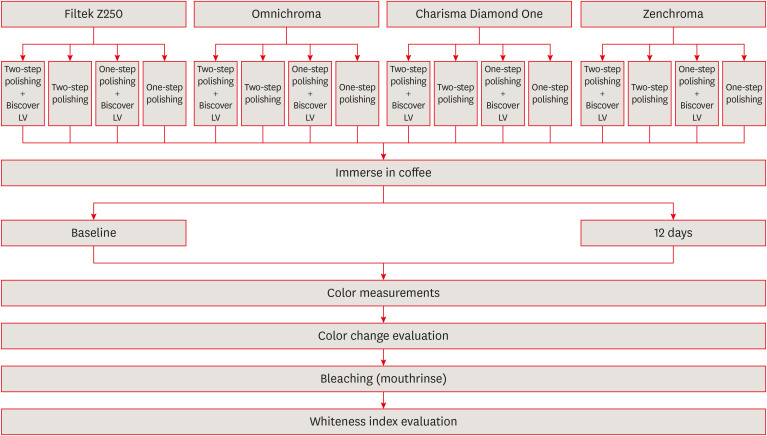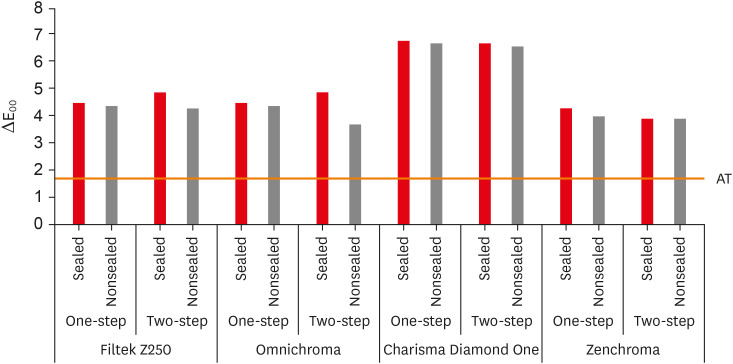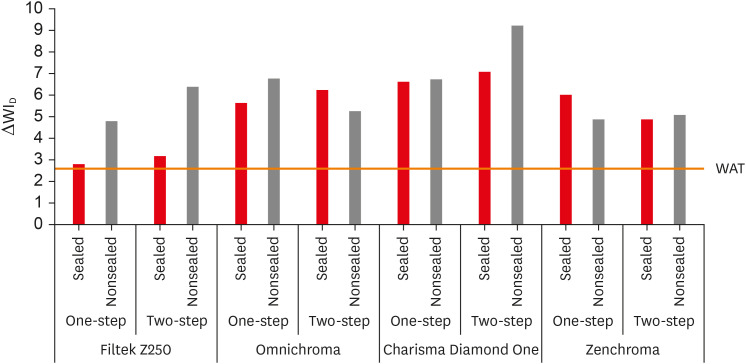Restor Dent Endod.
2024 Aug;49(3):e30. 10.5395/rde.2024.49.e30.
Effect of surface sealant on the color stability and whiteness index of single-shade resin composites after staining and bleaching
- Affiliations
-
- 1Department of Restorative Dentistry, Faculty of Dentistry, Usak University, Usak, Turkey
- KMID: 2559743
- DOI: http://doi.org/10.5395/rde.2024.49.e30
Abstract
Objectives
The aim of the current study was to evaluate the effect of polishing systems and surface sealant on the color stability and whiteness index of single-shade resin composites after staining and bleaching.
Materials and Methods
Three single-shade (Omnichroma, Charisma Diamond One, Zenchroma) and one multi-shade (Filtek Z250) materials were tested. From each resin composite, 40 specimens were prepared. The specimens were divided into 4 subgroups (n = 10) according to the surface treatments: 1-step polishing, 1-step + Biscover LV, 2-step polishing, and 2-step polishing + Biscover LV. Color differences (ΔE00 ) were calculated after being immersed in the coffee solution for 12 days. After the staining, the specimens were immersed in a whitening mouthrinse (Crest-3D White) for 12 hours. Whiteness index differences (∆WID = WID after staining − WID after bleaching) values were recorded. The generalized linear model was used for analysis (p < 0.05).
Results
The lowest and highest ΔE00 values were found for Zenchroma and Charisma Diamond One respectively. Sealed groups indicated higher ΔE00 values than nonsealed groups with significant differences (p = 0.008). The lowest and highest ΔWID values were found for Zenchroma and Charisma Diamond One respectively. Sealed groups indicated lower ΔWID values than nonsealed groups with significant differences (p = 0.022).
Conclusions
The use of surface sealant increased the discoloration and showed less whiteness change in resin materials. When the 1-step was compared with the 2-step polishing, the effects on the color stability and whiteness index values of the resin materials were similar.
Keyword
Figure
Reference
-
1. Bagheri R, Burrow MF, Tyas M. Influence of food-simulating solutions and surface finish on susceptibility to staining of aesthetic restorative materials. J Dent. 2005; 33:389–398. PMID: 15833394.2. Ertürk-Avunduk AT, Aksu S, Delikan E. The effects of mouthwashes on the color stability of resin-based restorative materials. Odovtos-Int J Dent Sc. 2021; 23:91–102.3. Bayraktar ET, Atali PY, Korkut B, Kesimli EG, Tarcin B, Turkmen C. Effect of modeling resins on microhardness of resin composites. Eur J Dent. 2021; 15:481–487. PMID: 34041724.4. Rizzante FA, Bombonatti JS, Vasconcelos L, Porto TS, Teich S, Mondelli RF. Influence of resin-coating agents on the roughness and color of composite resins. J Prosthet Dent. 2019; 122:332.e1–332.e5.5. Ebaya MM, Ali AI, El-Haliem HA, Mahmoud SH. Color stability and surface roughness of ormocer- versus methacrylate-based single shade composite in anterior restoration. BMC Oral Health. 2022; 22:430. PMID: 36167560.6. Alp CK, Gündogdu C, Ahısha CD. The effect of gastric acid on the surface properties of different universal composites: a SEM study. Scanning. 2022; 2022:9217802. PMID: 36636246.7. Gurgan S, Koc Vural U, Miletic I. Comparison of mechanical and optical properties of a newly marketed universal composite resin with contemporary universal composite resins: an in vitro study. Microsc Res Tech. 2022; 85:1171–1179. PMID: 34766666.8. Catelan A, Suzuki TY, Becker F Jr, Briso AL, Dos Santos PH. Influence of surface sealing on color stability and roughness of composite submitted to ultraviolet-accelerated aging. J Investig Clin Dent. 2017; 8:e12203.9. Lee YK, Powers JM. Combined effects of staining substances on resin composites before and after surface sealant application. J Mater Sci Mater Med. 2007; 18:685–691. PMID: 17136609.10. Korkut B, Bud M, Kukey P, Sancakli HS. Effect of surface sealants on color stability of different resin composites. Med Pharm Rep. 2022; 95:71–79. PMID: 35720239.11. Gömleksiz S, Gömleksiz O. The effect of contemporary finishing and polishing systems on the surface roughness of bulk fill resin composite and nanocomposites. J Esthet Restor Dent. 2022; 34:915–923. PMID: 35076168.12. Güler AU, Güler E, Yücel AÇ, Ertaş E. Effects of polishing procedures on color stability of composite resins. J Appl Oral Sci. 2009; 17:108–112. PMID: 19274395.13. Catelan A, Briso AL, Sundfeld RH, Goiato MC, dos Santos PH. Color stability of sealed composite resin restorative materials after ultraviolet artificial aging and immersion in staining solutions. J Prosthet Dent. 2011; 105:236–241. PMID: 21458648.14. Fidan M, Tuncdemir MT. Effect of whitening mouthrinses on color change, whiteness change, surface roughness, and hardness of stained resin composites. Am J Dent. 2023; 36:25–30. PMID: 36917712.15. Harorlı OT, Barutcigil C. Color recovery effect of commercial mouth rinses on a discolored composite. J Esthet Restor Dent. 2014; 26:256–263. PMID: 24974971.16. Schmitt VL, Nahsan FPS, Naufel FS, Vaez SC, Andrade GSD, Baseggio W, et al. Polishing techniques effect on microhybrid, nanohybrid and nanofilled composites color and surface roughness stability. Biosci J. 2016; 32:262–271.17. de Carvalho Justo AC, de Assuncao IV, Borges BC, da Costa GD. Impact of additional polishing on the roughness and surface morphology of dental composite resins. Rev Port Estomatol Med Dent Cir Maxilofac. 2016; 57:74–81.18. St-Pierre L, Martel C, Crépeau H, Vargas MA. Influence of polishing systems on surface roughness of composite resins: polishability of composite resins. Oper Dent. 2019; 44:E122–E132. PMID: 31046648.19. Dede DÖ, Şahin O, Koroglu A, Yilmaz B. Effect of sealant agents on the color stability and surface roughness of nanohybrid composite resins. J Prosthet Dent. 2016; 116:119–128. PMID: 26922208.20. Zimmerli B, Koch T, Flury S, Lussi A. The influence of toothbrushing and coffee staining on different composite surface coatings. Clin Oral Investig. 2012; 16:469–479.21. Doray PG, Eldiwany MS, Powers JM. Effect of resin surface sealers on improvement of stain resistance for a composite provisional material. J Esthet Restor Dent. 2003; 15:244–249. PMID: 12948218.22. Halacoglu DM, Yamanel K, Basaran S, Tuncer D, Celik C. Effects of staining and bleaching on a nanohybrid composite with or without surface sealant. Eur J Dent. 2016; 10:361–365. PMID: 27403054.23. Attar N. The effect of finishing and polishing procedures on the surface roughness of composite resin materials. J Contemp Dent Pract. 2007; 8:27–35.24. Ruschel VC, Bona VS, Baratieri LN, Maia HP. Effect of surface sealants and polishing time on composite surface roughness and microhardness. Oper Dent. 2018; 43:408–415. PMID: 29630480.25. Domingos PA, Garcia PP, Oliveira AL, Palma-Dibb RG. Composite resin color stability: influence of light sources and immersion media. J Appl Oral Sci. 2011; 19:204–211. PMID: 21625734.26. Rohym S, Tawfeek HE, Kamh R. Effect of coffee on color stability and surface roughness of newly introduced single shade resin composite materials. BMC Oral Health. 2023; 23:236. PMID: 37087507.27. Paravina RD, Ghinea R, Herrera LJ, Bona AD, Igiel C, Linninger M, et al. Color difference thresholds in dentistry. J Esthet Restor Dent. 2015; 27(Supplement 1):S1–S9. PMID: 25886208.28. Paravina RD, Pérez MM, Ghinea R. Acceptability and perceptibility thresholds in dentistry: a comprehensive review of clinical and research applications. J Esthet Restor Dent. 2019; 31:103–112. PMID: 30891913.29. Miranda DA, Bertoldo CE, Aguiar FH, Lima DA, Lovadino JR. Effects of mouthwashes on Knoop hardness and surface roughness of dental composites after different immersion times. Braz Oral Res. 2011; 25:168–173. PMID: 21537643.30. Pérez MM, Ghinea R, Rivas MJ, Yebra A, Ionescu AM, Paravina RD, et al. Development of a customized whiteness index for dentistry based on CIELAB color space. Dent Mater. 2016; 32:461–467. PMID: 26778404.31. Pérez MM, Herrera LJ, Carrillo F, Pecho OE, Dudea D, Gasparik C, et al. Whiteness difference thresholds in dentistry. Dent Mater. 2019; 35:292–297. PMID: 30527588.32. Paolone G, Formiga S, De Palma F, Abbruzzese L, Chirico L, Scolavino S, et al. Color stability of resin-based composites: staining procedures with liquids-a narrative review. J Esthet Restor Dent. 2022; 34:865–887. PMID: 35396818.33. Soares LE, Cesar IC, Santos CG, De Cardoso AL, Liporoni PC, Munin E, et al. Influence of coffee on reflectance and chemistry of resin composite protected by surface sealant. Am J Dent. 2007; 20:299–304. PMID: 17993026.34. Sabatini C, Campillo M, Aref J. Color stability of ten resin-based restorative materials. J Esthet Restor Dent. 2012; 24:185–199. PMID: 22691080.35. Kaizer MR, de Oliveira-Ogliari A, Cenci MS, Opdam NJ, Moraes RR. Do nanofill or submicron composites show improved smoothness and gloss? A systematic review of in vitro studies. Dent Mater. 2014; 30:e41–e78. PMID: 24529799.36. Erçin Ö, Kopuz D. The visual and instrumental analyses of different single-shade resin composites. Odovtos-Int J Dent Sc. 2024; 26:54–64.37. Spina DR, Grossi JR, Cunali RS, Baratto Filho F, da Cunha LF, Gonzaga CC, et al. Evaluation of discoloration removal by polishing resin composites submitted to staining in different drink solutions. Int Sch Res Notices. 2015; 2015:853975. PMID: 27347551.38. de Livi GJ, Santana TR, Bragança RM, de Bragança Garcez RM, Faria-E-Silva AL. The role of interface distance and underlying substrate on the color adjustment potential of single-shade composites. J Esthet Restor Dent. 2023; 35:1279–1285. PMID: 37435810.39. Yap AU, Yap SH, Teo CK, Ng JJ. Finishing/polishing of composite and compomer restoratives: effectiveness of one-step systems. Oper Dent. 2004; 29:275–279. PMID: 15195727.
- Full Text Links
- Actions
-
Cited
- CITED
-
- Close
- Share
- Similar articles
-
- Depth-Dependent Performance of Single-Shade Composite Resin: Assessing Color Adjustment Potential and Translucency
- Color Stability and Surface Roughness of Single-Shade Composite Resin after Finishing and Polishing
- Color discrepancy of single-shade composites at different distances from the interface measured using cell phone images
- The evaluation of color and color difference according to the layering placement of Incisal shade composites on the body composites of the indirect resin restoration
- Optical characteristics of resin composite before and after polymerization




